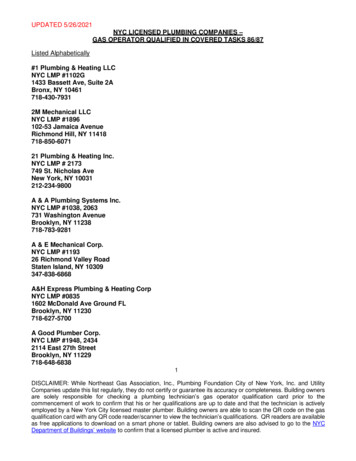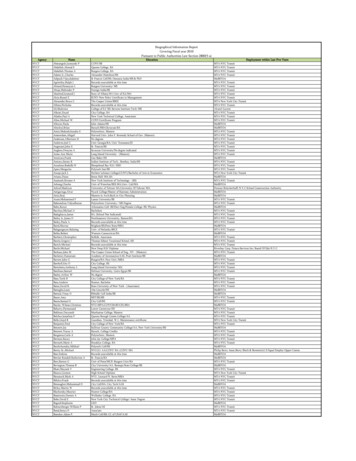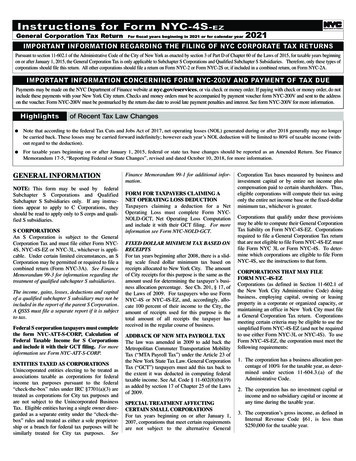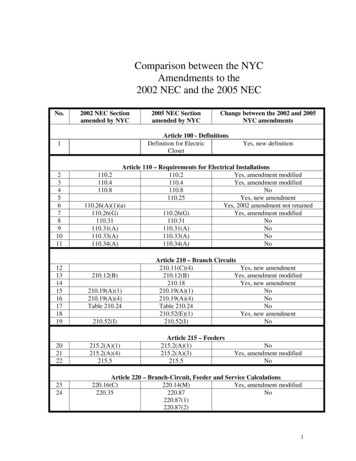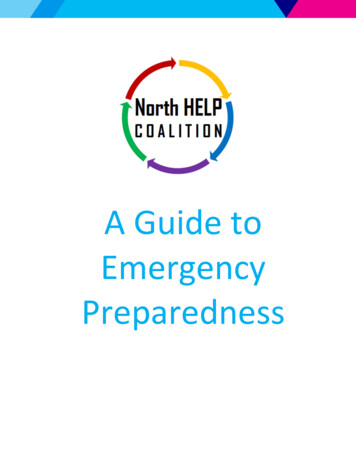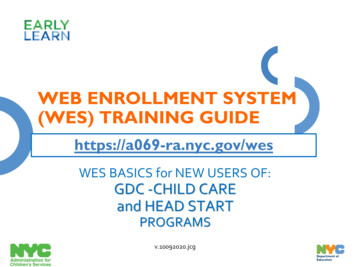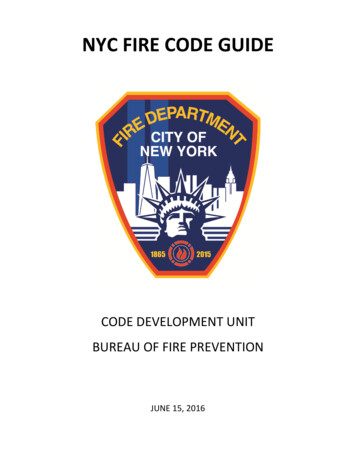
Transcription
NYC FIRE CODE GUIDECODE DEVELOPMENT UNITBUREAU OF FIRE PREVENTIONJUNE 15, 2016
NYC FIRE CODE GUIDEFREQUENTLY ASKED QUESTIONS AND RESPONSESPROVIDINGOFFICIAL INTERPRETATIONS AND GUIDANCENEW YORK CITY FIRE CODE(CHAPTER 2 OF TITLE 29 OF THE ADMINISTRATIVE CODEOF THE CITY OF NEW YORK)NYC FIRE DEPARTMENT RULES(TITLE 3 OF THE RULES OF THE CITY OF NEW YORK)GENERAL QUESTIONS1.What is the Fire Code?The New York City Fire Code is a City law that establishes fire safety requirements for a wide rangeof activities in New York City. These requirements govern such matters as emergencypreparedness; the prevention and reporting of fires; the manufacture, storage, handling, use andtransportation of hazardous materials and combustible materials; the conduct of various businessesand activities that pose fire hazards; and the design, installation, operation and maintenance of thebuildings and premises that house such materials, businesses and activities.2.To whom does the Fire Code apply?The Fire Code applies to all persons and places in New York City. Everyone must comply with itsprohibitions and fire safety requirements. Persons and businesses that conduct or supervise theactivities regulated by the Fire Code may also be required to obtain permits and certificates thatauthorize them to engage in those activities.3.When did the Fire Code take effect?The 2014 Fire Code took effect on March 30, 2014. It was the first periodic review and revision ofthe 2008 Fire Code, which took effect on July 1, 2008.The 2008 Fire Code was enacted by Local Law No. 26 of 2008. It was the first comprehensiverevision of the City’s fire code in a century. It was based on a model code, the International FireCode, published by the International Code Council, Inc.New York City Administrative Code §29-104, enacted as part of Local Law 26 of 2008, required thatno later than the third year after the effective date and every third year thereafter, the FireCommissioner shall review the latest edition of the International Fire Code and submit to the CityCouncil such proposed amendments as he or she may determine should be made to the Fire Codebased upon such model code.In accordance with Administrative Code §29-104, the Fire Department undertook a three-year codereview process in consultation with representatives of the City Council, New York City Department ofBuildings and industry, professional, trade and union organizations. This process culminated inproposed amendments that were approved by the City Council and signed into law by the Mayor as2
Local Law 148 of 2013 in December 2013. This amended Fire Code, which is referred to as the“2014 Fire Code” for convenient reference, took effect on March 30, 2014.4.What happened to the Fire Code in effect prior to July 1, 2008?The Fire Code in effect prior to July 1, 2008, known as the New York City Fire Prevention Code, wasrepealed on July 1, 2008.However, some of the design and installation provisions of the Fire Prevention Code continue to beapplicable to certain “pre-existing” installations that have been allowed to remain in use since July1, 2008, the effective date of the 2008 Fire Code, even though they are not in compliance with the2008 Fire Code’s requirements. The Fire Department has consolidated such Fire Prevention Codeprovisions into Chapter 48 of the Fire Department rules (Title 3 of the Rules of the City of New York)for convenient reference and enforcement purposes.5.Is there a “grace period” under which it is optional to file with the Fire Department underthe 2014 Fire Code?No, there is no grace period. However, provision is made for “projects in progress” at the time the2008 and 2014 Fire Codes took effect. See Chapter 1, Frequently Asked Question #13.6.How can I tell where in the 2014 Fire Code a 2008 Fire Code section can be found?Most section numbers in the 2014 Fire Code are unchanged from the 2008 Fire Code. 2008 FireCode sections that have been moved or renumbered are listed in the following cross-referencetable, with the section number of the corresponding 2014 Fire Code section. See the Fire CodeCross-Reference Table at the end of this Guide.7.I have questions about the Fire Code. Who should I contact at the Fire Department toobtain assistance?The best way to obtain assistance regarding the meaning of the Fire Code is to monitor thisFrequently Asked Questions page and to use the Fire Code inquiry form on this web site.To submit a Fire Code question, go the Code and Rules Public Feedback Page on the FireDepartment’s website (www.nyc.gov/fdny) and use the Public Inquiry Form.You may also submit your inquiry in writing to: Code Development Unit, Bureau of Fire Prevention,New York City Fire Department, 9 MetroTech Center, Brooklyn, NY 11201-3857.The Fire Department cannot provide an official interpretation of the Fire Code, or other officialguidance upon which you can rely, in response to a telephone inquiry.3
8.Will the existing Fire Department rules (as set forth in Title 3 of the Rules of the City ofNew York) remain in effect after the 2014 Fire Code becomes effective?Yes. The existing Fire Department rules will remain in effect unless and until they are repealed oramended at a later date.9.Does the Fire Department anticipate making any changes to its rules, or adopting newrules, in light of the 2014 Fire Code?Yes. In connection with the recent amendments to the Fire Code, the Fire Department haspromulgated rules to implement the provisions of the 2014 Fire Code. Certain rules, the provisionsof which were incorporated into the 2014 Fire Code, have been repealed.All existing and amended Fire Department rules are numbered to parallel the Fire Code chaptersand sections to which they correspond.All proposed and final rules, new and amended, may be viewed on this website on the “FDNY Rules”page.10. Where can I obtain a copy of the published version of the 2014 Fire Code?The new Fire Code can be purchased online or in person at Citystore, located in the MunicipalBuilding at One Centre Street, North Plaza, in Manhattan.11. How can I register a complaint with the Fire Department regarding a potential violation ofthe Fire Code or Fire Department rules?A complaint regarding a potential violation of the Fire Code or Fire Department rules can bereported to the Fire Department’s Bureau of Fire Prevention Field Public Operations Support Unit at(718) 999-2541.4
FC CHAPTER 1 - ADMINISTRATION1.I understand that all installations on or after March 30, 2014 must comply with ode,butisthereany“grandfathering” for installations that were approved or were under construction prior toMarch 30, 2014?FC 102.3 and 102.4 address facilities and conditions “lawfully existing” on June 30, 2008 andMarch 30, 2014 that would not be allowed or approved under the 2008 or 2014 Fire Code,respectively. Clarification of the scope and meaning of FC 102.3 and 102.4 is set forth in FireDepartment rule 3 RCNY 102-01, which was recently amended to address “grandfathering” issuesarising from the enactment of the 2014 Fire Code.2.FC 102.3 and 102.4 state that lawfully existing facilities whose design and installationwould not be allowed or approved under the 2014 Fire Code can be continued under priorlaws, rules and regulations. FC102.5 contains certain exceptions, one of which requirescompliance with the Fire Code when the part of the building in which the installationexists undergoes alteration. Is alteration defined?Yes. FC202 defines “alteration” as any addition to, or modification of, an existing installation, otherthan repairs made in the ordinary course of maintenance. An example of an alteration would be theinstallation of a new system, or the removal and replacement of an existing system. An example ofan ordinary repair would be the servicing or replacement, in kind, of components of an existinginstallation. Certain Fire Code sections (FC501.4.3.1 is an example) may set forth specificstandards for alterations that trigger Fire Code compliance.3.I own a single family home in Broad Channel, Queens, that was severely damaged bySuperstorm Sandy in October 2012.The damage extended to the propane installationthat fuels my kitchen stove and clothes dryer.What Fire Code requirements and FireDepartment approvals are required to repair and restore my propane installation?The Fire Code strictly regulates Liquefied Petroleum Gases (LPG), commonly referred to as propane,and prohibits its use for household purposes where piped natural gas is available from a publicutility.Broad Channel is one of the few areas in New York City that is not supplied with piped natural gas.Many of the single family homes in Broad Channel were constructed in the 1930s and 1940s andsince that time have used propane to fuel cooking appliances and clothes dryers.The Fire Code authorizes continuation of lawful installations pre-dating the requirements of the 2008and 2014 Fire Code, with certain exceptions. FC102.3 and Fire Department rule 3 RCNY §4838-01authorize continuation of existing lawful residential use of propane for cooking and clothes dryingpurposes where piped natural gas is not available.The Fire Department has determined to treat the restoration of Sandy-damaged stationary propaneinstallations for these residential purposes as a repair, not an alteration. As such, the owner of aone or two family home in Broad Channel may restore a stationary propane installation lawfullyused for residential cooking and/or clothes drying as of the date of Superstorm Sandy (October 29,2012) and does not have to comply with the design and installation requirements of FC Chapter 385
and Fire Department rule 3 RCNY §3809-01 that are applicable to newly-constructed or alteredstationary propane installations.Broad Channel homeowners do not have to obtain any Fire Department approvals for repairs totheir lawfully existing propane residential cooking and/or clothes drying installations provided thatthey meet the following interim guidelines:1.The homeowner has documentation (such as invoices from a plumber or propane supplier)that establishes that stationary propane installation was in operation at the premises as ofOctober 29, 2012.2.The quantity of propane fueling the cooking and/or clothes drying appliances is unchangedfrom the amount in use on October 29, 2012, and in no case exceeds two (2) propanetanks.3.All propane tanks are located outdoors and the size (capacity) of each individual propanetank does not exceed one hundred (100) pounds of propane.4.There is no reserve storage of propane (unconnected spare tanks) at the premises.5.The propane installation is used only for cooking and/or clothes drying purposes and for noother purpose.6.With respect to any propane installation originally installed on or after March 1, 2000, nopropane tank shall be located within five (5) feet of:(A) any building opening, including any door, openable window or intake or exhaust vent;(B) the nearest lot line, sidewalk or building on an adjoining lot;(C) a parked motor vehicle; and/or(D) any vent or fill line of a fuel oil storage tank.7.All repairs necessary to restore the propane installation, including repairs to the piping andequipment, shall be made by a plumber licensed by the New York City Department ofBuildings in accordance with the requirements of the Fire Code and the New York CityConstruction Codes, including the Fuel Gas Code.Any homeowner that meets these interim guidelines (and can document that the installation was inoperation at the premises as of October 29, 2012, the date of Superstorm Sandy) may restore theirpropane residential cooking and clothes drying installation without filing design and installationdocuments with the Fire Department.Any homeowner with an installation that does not meet these interim guidelines should contact theTechnology Management Unit of the Bureau of Fire Prevention at (718) 999-2405 orSuzanne.Ledan@fdny.nyc.gov for instructions about filing an application for Fire Department reviewof the installation.4.Is there a convenient way to identify the types of installations that require design andinstallation documents to be submitted to the Fire Department for approval?6
Yes. FC105.4 lists the types of installations requiring submission of design and installationdocuments. See the list of installations requiring submission of design and installation documents atthe end of this Guide.5.Is there a convenient way to identify the materials, operations and facilities that requirea Fire Code permit?Yes. FC 105.6 lists all of the permits required by the Fire Code.6.Am I required to obtain a permit for an existing business or activity that did notpreviously require a permit?Yes. Existing businesses will be required to secure permits that are required by the 2014 Fire Code,even if they were not required previously. You will have until March 30, 2015 (one year from theeffective date of the 2014 Fire Code) to obtain the new permit.If the permit is for an existing installation, in most cases existing businesses will not be required tocomply with 2014 Fire Code design and installation requirements in order to obtain the permit. Theexceptions are set forth in FC102.5 and Fire Department rule 3 RCNY 102-01.7.Is there a convenient way to identify the Fire Code’s certificate requirements, especiallythose that are new to the 2014 Fire Code?Yes. A list of all required Certificates of Fitness and Company Certificates is posted on the FireDepartment’s website, www.nyc.gov/fdny.FC113 lists the general requirements for Fire Department Certificates of Fitness and Certificates ofQualification; FC114 for Certificates of License; and FC115 for Company Certificates. Additionalrequirements are set forth in the following Fire Department rules: 3 RCNY 113-01, 113-02, 113-03,113-08, 113-09 and 113-11 for Certificates of Fitness and Certificates of Qualification; 3 RCNY 11401 for Certificates of License; and 3 RCNY 115-01 for Company Certificates.8.Am I required to obtain certificates for an existing business or activity that under the2008 Fire Code did not require a Fire Department certificate?Yes. Individuals and existing businesses will be required to secure certificates that are now requiredby the 2014 Fire Code, even if they were not required previously. You will have until March 30,2015 (one year from the effective date of the 2014 Fire Code) to obtain the new certificate.9.I currently hold a certificate issued by the Fire Department. Is my certificate still validafter the 2014 Fire Code took effect on March 30, 2014?Yes. Your certificate remains valid until its expiration, unless you are notified otherwise by the FireDepartment. Upon renewal, some certificate holders may be required to demonstrate knowledge ofthe 2014 Fire Code requirements by attending a continuing education program or passing acertificate examination. Current certificate holders will be notified in advance of the certificate’sexpiration date of any such requirements.7
10. What are the Fire Code’s “operational and maintenance” requirements?Operational requirements are those that relate to the operation and supervision of equipment andpremises. Permits, supervision and certificate requirements, emergency preparedness plans,recordkeeping, markings and the posting of signs, and prohibitions against smoking are examples ofoperational requirements.Maintenance requirements are those that relate to keeping equipment and premises in goodworking order and a safe condition. Housekeeping, servicing and periodic testing and inspection ofequipment, and prevention and removal of obstructions to means of egress are examples ofmaintenance requirements.11. As the owner of an existing building or business, am I required to comply with the 2014Fire Code’s operational and maintenance requirements, or those contained in the 2008Fire Code?You are required to comply with the 2014 Fire Code’s operational and maintenance requirements.The operational and maintenance requirements set forth in the 2008 Fire Code have beensuperseded by the 2014 Fire Code.If you encounter a situation where it is impossible or impracticable to comply with the 2014 FireCode’s operational or maintenance requirements, seek Fire Department guidance as to how tocomply with the Fire Code and/or seek a modification of the Fire Code’s requirements (see GeneralFrequently Asked Question #7).12. My facility was granted Fire Department modifications from certain provisions of therepealed Fire Prevention Code and the 2008 Fire Code. Will these modifications still bevalid under the 2014 Fire Code?Yes, unless the Fire Department determines that one of the exceptions to pre-existing facilities andconditions set forth in FC102.5 applies to your facility.13. I have filed and obtained various approvals from the New York City Department ofBuildings and other regulatory agencies prior to the effective date of the 2014 Fire Codefor a number of projects that will not be commenced until after March 30, 2014 (theeffective date of the 2014 Fire Code). Certain design elements of these projects do notconform with the 2014 Fire Code requirements? Can I proceed with these projects?Generally speaking, any new installation on or after March 30, 2014 (the effective date of the 2014Fire Code) must comply with the 2014 Fire Code design and installation requirements. However,special consideration is given to certain “projects in progress” in recognition of the hardship thatwould result if the new design and installation requirements were imposed on buildings or otherprojects that are fully designed and/or in the process of being constructed or installed.Fire Department rule 3 RCNY 102-01 allowed certain projects in progress at the time the 2008 FireCode took effect to be constructed under the prior code requirements if completed within a specifiedtimeframe. In order for the work to be considered a project in progress under the criteria specifiedin Section 102-01(f), the applicant must have obtained a Department of Buildings work permit priorto the effective date of the Fire Code. This ensures that the work that is to be undertaken or8
continued after the effective date of the new code requirements legitimately pre-dates the new coderequirements.The Fire Department has amended Rule 102-01 to provide a similar grace period for projects inprogress as of the effective date of the 2014 Fire Code.For solar panel installations on pitched roofs filed and/or approved prior to the effective date of the2014 Fire Code, see Chapter 5, Frequently Asked Question #36.9
FC CHAPTER 2 - DEFINITIONS1.Where can I find the definitions for terms used in the Fire Code?FC Chapter 2 contains a complete list of all defined terms used in the Fire Code. FC Chapter 2sets forth definitions for all administrative terms used in the Fire Code, as well as referencing, bysection number, terms defined in the individual Fire Code chapters.2.Where can I find the definitions for terms used in the Fire Department rules?Fire Department rules italicize terms that are defined in the Fire Code. In addition, certain definedterms are used in the rules. These defined terms are also italicized and are listed in FireDepartment rule 3 RCNY 202-01.10
FC CHAPTER 3 - GENERAL PRECAUTIONS AGAINST FIRE1.Are tar kettles permitted to be utilized on the roof of buildings?No. FC303.2 prohibits the use of tar kettles on the roof of any building. However, the Fire Codedoes allow LPG-fueled asphalt melters to be used on the roof of buildings that have noncombustibleroofs under certain circumstances, as set forth in Fire Department rule 3 RCNY 3809-01.2.I notice that stores and catalogs advertise and sell for backyard use portable outdoor firepits. These fire pits burn wood in a metal dish that looks like a big wok, sometimes withscreening. I am aware that the Fire Code regulates barbecues. Does it regulate fire pitsas well?Yes. Portable outdoor fire pits that burn wood or other solid fuel (such as manufactured firelogs) areregulated by the Fire Code as an open fire. The Fire Code (FC307.1) prohibits open fires, with afew exceptions, because of the fire hazards they present. The main exception allows barbecues thatburn charcoal, propane or piped natural gas (See Frequently Asked Questions #3, 4 and 5). Thefuels used in a barbecue generate heat or a controlled flame, as opposed to the uncontrolled firethat is created by the open burning of wood in fire pits.3.I am the managing agent for a high-rise apartment building. The tenants would like tobarbecue on the balconies, rooftop and rear yards.Does the Fire Code have anyrestrictions or prohibitions?Yes. FC307.5 regulates the operation and maintenance of charcoal, piped natural gas, LPG andelectric barbecues on all properties, including apartment building properties. You should refer toFC307.5 for complete requirements.All barbecues, regardless of the type of fuel used, are required to be operated outdoors (such as ona balcony or rooftop or in a rear yard) and at least 10 feet from combustible materials, includingcombustible building surfaces, combustible roofs and combustible decks. This restriction willeffectively preclude the use of a barbecue on many balconies and rooftops, including on the roof ofany apartment building with a combustible roof. Additionally, rooftops are not generally designed orsafe for occupancy.You should consult with an engineer, architect or the New York CityDepartment of Buildings regarding the safe and lawful use of any rooftop.Use of propane (LPG)-fueled barbecues on apartment building properties is restricted to barbecuesfueled by one 16.4 ounce container of LPG (the size of LPG container commonly used for hand-heldpropane torches). A maximum of four 16.4 ounce propane containers may be stored in anyindividual apartment. No LPG may be stored in any basement or cellar.All barbecues must be constantly attended and there must be ready access to fire extinguishingequipment, as set forth in FC307.5.See Frequently Asked Question #4 for barbecue requirements for private dwellings and FrequentlyAsked Question #5 for commercial properties.11
4.I live in a private dwelling (1 or 2 family home). Can we have a barbecue on the balconyor roof deck and/or in the rear yard?If it is allowed, are there any restrictions onbarbecue use on the property?Yes. FC307.5 regulates the operation and maintenance of charcoal, piped natural gas, LPG andelectric barbecues on all properties, including private dwelling properties. You should refer toFC307.5 for complete requirements.All barbecues, regardless of the type of fuel used, are required to be operated outdoors and at least10 feet from combustible materials, including combustible building surfaces, combustible roofs andcombustible decks. This restriction will effectively preclude the use of a barbecue on manybalconies and rooftops, including on the roof of any private dwelling with a combustible roof.Additionally, rooftops are not generally designed or safe for occupancy. You should consult with anengineer, architect or the New York City Department of Buildings regarding the safe and lawful useof any rooftop.Additionally, propane (LPG)-fueled barbecues located and used on a balcony or roof deck are limitedto those having a container not exceeding 16.4 ounces of LPG, with not more than 4 suchcontainers in any dwelling unit. LPG fueled barbecues located and used in rear yards are limited tothose having a container not exceeding 20 pounds of LPG, with not more than 2 such containersstored outdoors on the property (one in use and one reserve container). LPG containers with acapacity exceeding 16.4 ounces are not allowed to be stored indoors. No LPG may be stored in anybasement or cellar.All barbecues must be constantly attended and there must be ready access to fire extinguishingequipment, as set forth in FC307.5.See Frequently Asked Question #3 for barbecue requirements for apartment buildings andFrequently Asked Question #5 for commercial properties.5.My business occupies an office building. I would like to have a summer barbecue for mystaff on the rooftop or in the rear yard. Does the Fire Code restrict or prohibit barbecuesin these areas?Yes. FC307.5 regulates the operation and maintenance of charcoal, piped natural gas and electricbarbecues on all properties, including commercial properties. Unlike residential properties, propane(LPG)-fueled barbecues are not allowed on commercial properties. You should refer to FC307.5 forcomplete requirements.All barbecues, regardless of the type of fuel used, are required to be operated outdoors and at least10 feet from combustible materials, including combustible building surfaces, combustible roofs andcombustible decks. This restriction will effectively preclude the use of a barbecue on many rooftops,including on the roof of a commercial establishment with a combustible roof. Additionally, rooftopsare not generally designed or safe for occupancy. You should consult with an engineer, architect orthe New York City Department of Buildings regarding the safe and lawful use of any rooftop.All barbecues must be constantly attended and there must be ready access to fire extinguishingequipment, as set forth in FC307.5.See Frequently Asked Question #3 for barbecue requirements for apartment buildings andFrequently Asked Question #4 for private dwellings.12
6.I own an electric cooking grill which has its heating elements embedded within a solidcooking surface. Is this type of grill considered an “electric barbecue” regulated byFC307.5.1?No. An electric grill which has its heating elements embedded within a solid cooking surface is notan electric barbecue. For purposes of FC307.5.1, as set forth in FC302.1, an electric barbecue isdefined as “any device designed for heating or cooking food on an open grate cooking surface aboveexposed heating elements”. An electric grill that has its heating elements embedded within a solidcooking surface is not an electric barbecue. Electric barbecues present the fire safety hazard ofgrease from the heating or cooking process dripping on the heating elements and being ignited.It is important to note that barbecue-size electric grills require a substantial amount of electriccurrent. Be sure that the electrical outlet into which you plug the grill has sufficient current to safelyoperate the grill (see Chapter 6, Frequently Asked Question #3) and that if you use an extensioncord you comply with the fire safety requirements of FC605.5.7.Are coke-fueled salamanders at a construction site allowed to be used for concrete dryingand curing?Yes. Coke-fueled salamanders were allowed by the New York City Fire Prevention Code but werenot included as an allowed type of open fire in the 2008 Fire Code. In response to constructionindustry requests, the Fire Department has, since 2008, allowed the use of coke-fueled salamandersat construction sites through granting of modifications.The 2014 Fire Code, in FC 307.1 and 307.6, allows the use of coke-fueled salamanders forconstruction-related drying and curing, subject to permit requirements, supervision requirementsand other safety requirements to be established by rule.8.My school conducts candle-lighting ceremonies as a memorial on certain holidays or tocreate a spiritual or festive atmosphere on other occasions. We understand that candlesare a common cause of fires and we want to be sure that we can conduct theseceremonies lawfully and safely. Does the Fire Code allow candle use in an educationaloccupancy and, if so, does the Fire Department offer any guidance as to how candlelighting ceremonies should be conducted?The Fire Code regulates the use of candles and other open flames, which are the cause of manyfires. FC308.2 prohibits candles in college and university dormitories; in any place in whichhazardous material is stored, handled or used; or where the open flame could ignite combustiblematerials or vapors.The Fire Code (in FC308.3) strictly regulates the use of candles in any place of assembly. Thisincludes school auditoriums, cafeterias and classrooms that are designed to be occupied by morethan 75 persons. Any use of candles in these spaces requires a Fire Department permit and mustcomply with the detailed requirements of FC308.3.The Fire Code does not specifically prohibit or regulate candle use in classrooms or other areas of aneducational occupancy (kindergarten through 12th grade) that are not places of assembly.The Fire Department does not encourage use of lit candles in any occupancy, given the fire safetyhazards associated with open flames. However, the Fire Department recognizes that candle-lightingis a traditional observance. Also, educational occupancies typically have noncombustible finishes13
and fewer combustible materials than, for example, a residential occupancy. Accordingly, the FireDepartment offers the following guidance with respect to candle use in rooms or areas ofeducational occupancies that are not places of assembly.Whenever a candle is being lit, handled and/or left lit, the following fire safety precautions shall betaken:9.1.Candles may be lit, carried and left lit only in rooms or areas that do not contain hazardousmaterials or vapors. (Science laboratories and art rooms may contain such materials.)2.Candles must be lit, carried and left lit a safe distance away from combustible material(including drapes, decorations, upholstered furniture and papers).3.Candles should be lit only by an adult, or under the individualized and immediatesupervision of an adult who, if necessary, can intervene to ensure safe lighting.4.Candles should be carried only by an adult, or under the individualized and immediatesupervision of an adult who, if necessary, can intervene to ensure safe handling.5.All persons involved in candle-lighting or handling lit candles should avoid loose clothing orcostumes, and long hair should be tied back.6.Candles t
nyc fire code guide . code development unit . bureau of fire prevention . june 15, 2016 . 2 . nyc fire code guide . frequently asked questions and responses . providing . official interpretations and guidance . new york city fire code (chapter 2 of title 29 of the administrative code .
